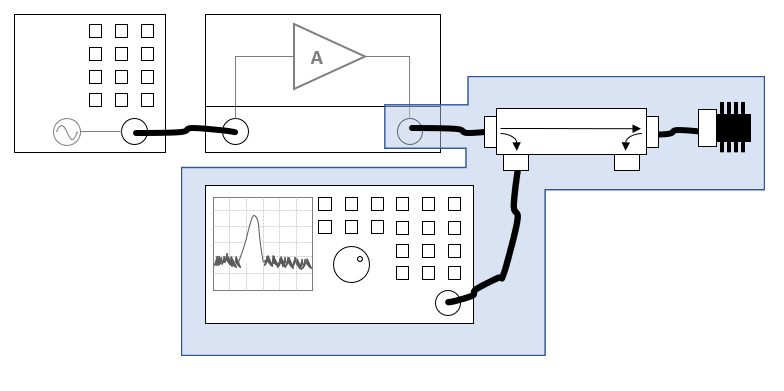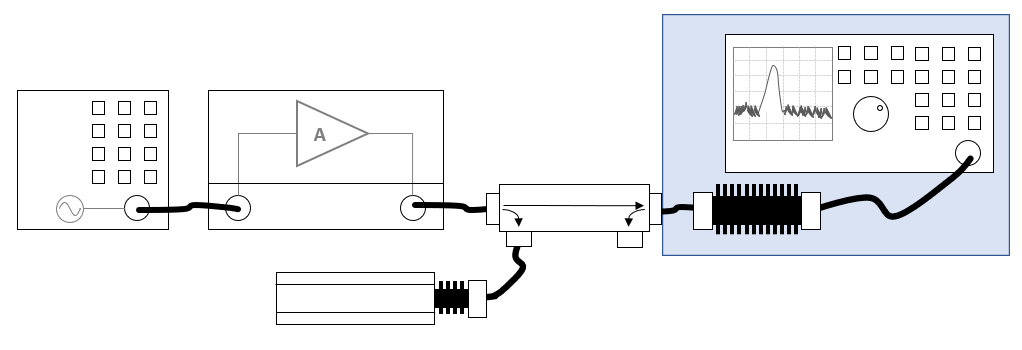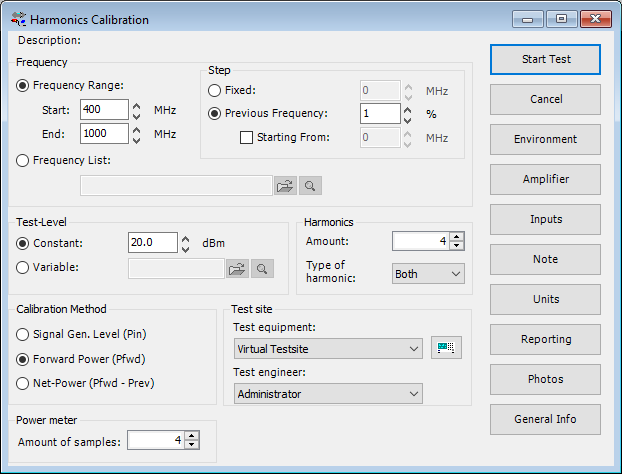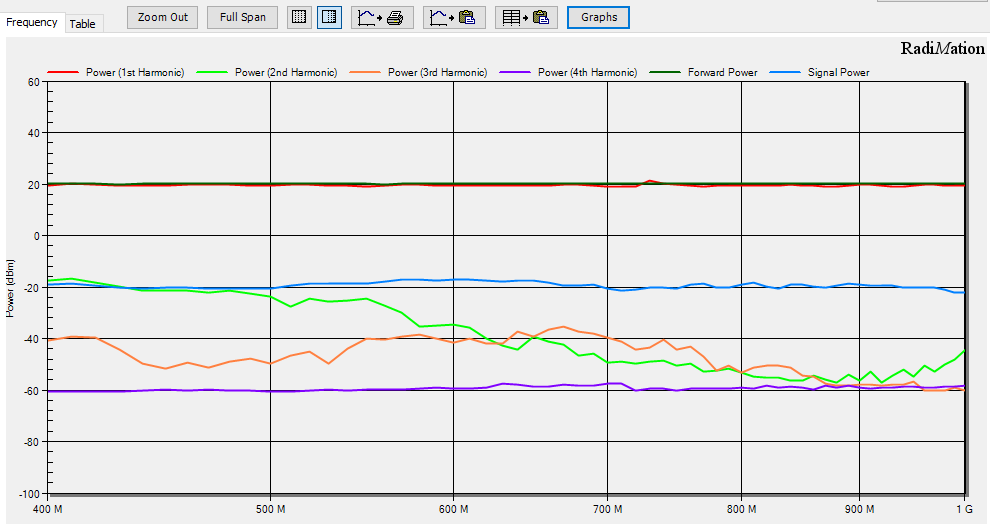RadiMation Application Note 115
How to measure amplifier harmonics using RadiMation[edit]
This application note explains how RadiMation® can be used to perform accurate measurement of the harmonics that are generated by an amplifier.
The measurement of the harmonics is often needed to ensure that the used amplifier in the setup is not generating too much power on multiples of the carrier frequency.
The first harmonic is the same as the generated CW signal which is the input signal for the amplifier. The second harmonic is present at 2x the CW frequency. The third harmonic is present at 3x the CW frequency, and so on.
As the harmonics are thus present on higher frequencies than the CW signal, all the equipment that is connected to the output of the amplifier up to and including the used spectrum analyser should be able to be used on those higher frequencies. For an amplifier of 80 MHz - 1000 MHz, measuring up to the 6th harmonic, it is thus necessary that the measurement equipment is usable up to 6 GHz. The measurement equipment that should be able to measure those higher frequencies are shown in the blue areas in the equipment drawings below.
Overview[edit]
There are three possible setups of the used equipment to measure amplifier harmonics. Each method has its own advantages, and small differences in the used equipment. These setups and methods are explained in the following sections:
- Measure the power of all harmonics using a spectrum analyser.
- Measure the broadband power with a powermeter and the harmonics using a spectrum analyser.
- Measure the actual field harmonics using a receive antenna.
Which equipment setup is used, is depending on the equipment that is selected in the testsite that is being used for the harmonics calibration.
- If the selected testsite has a device driver selected for the Sensor power meter, then the 'Measure the broadband power with a powermeter and the harmonics using a spectrum analyser' method will be used.
- Otherwise, if the selected testsite has a device driver selected for the Spectrum analyser, then the 'Measure the actual field harmonics using a receive antenna' method will be used.
- In all other cases the 'Measure the power of all harmonics using a spectrum analyser' method will be used.
Measure the power of all harmonics using a spectrum analyser[edit]
In this configuration, the forward power and the harmonics are all measured with the spectrum analyser. The harmonics are thus referenced to the forward power that is only generated by the 1st harmonic. This configuration is often used to measure the harmonics that are generated by the amplifier itself, to characterise and test the amplifier itself.
A schematic drawing of the used equipment is:
The blue area contains the equipment that should be able to measure the highest frequency of the harmonics that are being measured.
For the 'Load' a high power RF load can be used, or it can also be the normally to be used intended equipment, like for example the antenna in an anechoic chamber.
To use only the spectrum analyser the Forward power meter in the testsite has to be selected to be the spectrum analyser device driver. Keep in mind to not select any device for the sensor power meter on the 'Devices 2' tab.
| # | Device name | Tab in testsite configuration window | suitable for harmonic frequencies | note |
|---|---|---|---|---|
| Signal Generator | Devices 1 | no | ||
| Amplifier | Devices 1 | no | This is the amplifier of which the harmonics are being measured. | |
| Coupler | Devices 1 | yes | ||
| Forward power meter | Devices 1 | yes | The powermeter device driver for the analyser that is being used to measure the harmonics. | |
| Cables | ||||
| ① | Cable SG -> amplifier | Cables | no | Optional to correct for the cable loss between the signal generator and the amplifier |
| ② | Cable amplifier -> coupler | Cables | yes | Optional to correct for the cable loss between the amplifier and the coupler |
| ③ | Cable coupler -> forward power meter | Cables | yes | Optional to correct for the cable loss between the coupler and the forward power meter |
Measure the broadband power with a powermeter and the harmonics using a spectrum analyser[edit]
In this configuration, the forward power is measured with a broadband powermeter, which is measuring the combined power of the 1st and the additional harmonics. The harmonics are thus referenced to the forward power for the total power that is generated by the amplifier, including all harmonics. This configuration is often used to measure the harmonics that are generated by the amplifier, in an actually equipment setup, to characterise the used combination of equipment during actual immunity testing.
Some standards like the IEC 61000-4-3 describe that the harmonic content in the field strength should be specified. By using this setup, only the harmonic content in the power is measured, and the antenna factor of the used antenna should still be used to calculate the harmonic content in the field strength.
A schematic drawing of the used equipment is:
The blue area contains the equipment that should be able to measure the highest frequency of the harmonics that are being measured. The coupler itself does not need to be suitable for the highest frequency of the harmonics, if it is the same coupler as is used in the measurement setup. Be sure to use sufficient attenuation in front of the analyser because it is directly connected to the output of the amplifier, and high power can be present. It is possible to correct the spectrum analyser with the attenuation of the attenuator, however this is not needed, as the measurement of gain of the harmonics (in dBc) is a relative measurement related to the first harmonic.
When using the powermeter to setup the required testlevel and a spectrum analyser to measure the harmonics, the power meter needs to be selected as the forward powermeter, and the 'devices 2' tab the spectrum analyser needs to be selected as the sensor power meter.
| # | Device name | Tab in testsite configuration window | suitable for harmonic frequencies | note |
|---|---|---|---|---|
| Signal Generator | Devices 1 | no | ||
| Amplifier | Devices 1 | no | This is the amplifier of which the harmonics are being measured. | |
| Coupler | Devices 1 | no | ||
| Forward power meter | Devices 1 | no | The powermeter device driver for the broadband power measurement of the forward power. | |
| Sensor power meter | Devices 2 | yes | The powermeter device driver for the analyser that is being used to measure the harmonics. | |
| Cables | ||||
| ① | Cable SG -> amplifier | Cables | no | Optional to correct for the cable loss between the signal generator and the amplifier |
| ② | Cable amplifier -> coupler | Cables | no | Optional to correct for the cable loss between the amplifier and the coupler |
| ③ | Cable coupler -> forward power meter | Cables | no | Optional to correct for the cable loss between the coupler and the forward power meter |
| ④ | Cable current -> power meter | Cables | yes | Optional to correct for the cable loss between the coupler and the spectrum analyser (which is the sensor power meter) |
| ⑤ | Cable current -> power meter | Cables | yes | Optional to correct for the attenuator between the coupler and the spectrum analyser (which is the sensor power meter) |
| ⑥ | Cable current -> power meter | Cables | yes | Optional to correct for the cable loss between the coupler and the spectrum analyser (which is the sensor power meter) |
The signal path between the coupler and the spectrum analyser often consists of multiple cable segments. Each cable segment can have its own correction, and multiple corrections can be selected and added to the testsite configuration. The combined correction of all the selected cable segments will be used for the correction.
Measure the actual field harmonics using a receive antenna[edit]
In this configuration, the forward power is measured with a broadband powermeter, which is measuring the combined power of the 1st and the additional harmonics. The harmonics are thus referenced to the forward power for the total power that is generated by the amplifier, including all harmonics. This configuration is often used to measure the harmonics that are generated by the amplifier, in an actually equipment setup, to characterise the used combination of equipment during actual immunity testing.
Some standards like the IEC 61000-4-3 describe that the harmonic content in the field strength should be measured and verified. By using this setup, the harmonic content in the field strength is directly measured, and the actual gain of the transmitting antenna is present in the measurement results.
The advantage of this setup is that the actual harmonics of the electrical field generated in the actual measurement setup can be measured.
A schematic drawing of the used equipment is:
The blue area contains the equipment that should be able to measure the highest frequency of the harmonics that are being measured. Be sure to use sufficient attenuation in front of the analyser to because a high electrical field strength can be generated, and thus a much stronger signal than during emission test can be present on the receiving antenna. It is possible to correct the spectrum analyser with the attenuation of the attenuator, however this is not needed, as the measurement of gain of the harmonics (in dBc) is a relative measurement related to the first harmonic.
When using the powermeter to setup the required testlevel and a spectrum analyser to measure the electrical field strength, the power meter needs to be selected as the forward powermeter, and the spectrum analyser needs to be selected as the spectrum analyser on the 'Devices 2' tab. In this configuration, no sensor powermeter should be selected on the 'Devices 2' tab.
| # | Device name | Tab in testsite configuration window | suitable for harmonic frequencies | note |
|---|---|---|---|---|
| Signal Generator | Devices 1 | no | ||
| Amplifier | Devices 1 | no | This is the amplifier of which the harmonics are being measured. | |
| Coupler | Devices 1 | no | ||
| Forward power meter | Devices 1 | no | The powermeter device driver for the broadband power measurement of the forward power. | |
| Calibration antenna | Devices 1 | yes | The antenna that is used for the receiving of the generated electrical fields on the harmonics. | |
| Spectrum analyser | Devices 2 | yes | The device driver for the analyser that is being used to measure the harmonics. | |
| Cables | ||||
| ① | Cable SG -> amplifier | Cables | no | Optional to correct for the cable loss between the signal generator and the amplifier |
| ② | Cable amplifier -> coupler | Cables | no | Optional to correct for the cable loss between the amplifier and the coupler |
| ③ | Cable coupler -> forward power meter | Cables | no | Optional to correct for the cable loss between the coupler and the forward power meter |
| ④ | Cable preamp -> analyser | Cables | yes | Optional to correct for the attenuator between the receive antenna and the spectrum analyser |
| ⑤ | Cable preamp -> analyser | Cables | yes | Optional to correct for the cable loss between the receive antenna and the spectrum analyser |
The signal path between the receive antenna and the spectrum analyser often consists of multiple cable segments. Each cable segment can have its own correction, and multiple corrections can be selected and added to the testsite configuration. The combined correction of all the selected cable segments will be used for the correction.
Configuring the calibration[edit]
To start the harmonics calibration first, open an EUT file. This EUT file represents the amplifier, which is the actual Equipment Under Test (EUT). By maintaining this EUT file, a yearly remeasurement of the harmonics of the amplifier will all be present in the same EUT file.
Once the EUT file is opened, select from the menu:
-
 Calibration
Calibration
-
 EUT Calibration
EUT Calibration
-
 Harmonics
Harmonics
-
-
-
The configuration window for the harmonics calibration will be shown, which allows to configure all the parameters.
The following parameters are available to be configured in the TSF:
| The name of the selected TSF file. |
| Sets the frequency specification to a frequency range. |
| Sets start frequency. |
| Sets end frequency. |
| Sets a fixed step size from start to end frequency. |
| Sets a logarithmic step size from start to stop frequency |
| Sets the start frequency for a logarithmic step from which the actual measurement frequencies will be calculated. The starting from frequency should be lower than the actual start frequency. The test will start at the first calculated frequency that is equal to or higher than the specified start frequency. |
| With frequency list the operator can select a frequency list file by browsing to the file location. The frequencies inside the frequency list file will be measured. |
| The test level can be set to a constant level to which the power should be regulated. |
| A .COR file can also be used. This can be the same file as for the Frequency List. |
| The number of harmonics that should be measured. |
| If only the even, odd or both (even and odd) harmonics should be measured. |
| On which power levelling point the desired testlevel should be regulated. |
| In the test site window the test engineer can select which equipment list will be used during this test. This also determines which method and equipment is being used. |
| In the test engineer window, the test engineer can select its own name. The test engineer name will be stored by the test results |
| The amount of measurements that are measured on each harmonic to determine its power. The average of these measurements will be used as the power of the harmonic. |
| Starts the configured calibration. |
| Cancel the configured calibration. |
| Display the environment window. |
| Display the note window. |
| Display the Units configuration window |
Calibration procedure[edit]
The procedure that is used to perform the calibration of the harmonics is:
- Set the signal generator to the first frequency and a low power.
- Measure the power using the forward powermeter. If the power is within the desired tolerance, continue at step 4.
- Adjust the signal generator carrier level. If the forward power was too high, reduce the carrier level, otherwise increase the carrier level.
- Use the spectrum analyser to measure the first harmonic
- Use the spectrum analyser to measure the other harmonics that should be measured
- Increase the signal generator carrier frequency to the next frequency. continue at step 2.
This measurement can thus for example result in the following measurement results. The measurements are thus performed from top to down, for the first column, and then top to down for the second column, and so on.
| Carrier frequency | 100 MHz | 200 MHz | 300 MHz | 400 MHz | 500 Mhz |
|---|---|---|---|---|---|
| Forward power | 56.0 dBm | 56.1 dBm | 56.2 dBm | 56.1 dBm | 56.0 dBm |
| 1st harmonic | 55.9 dBm @ 100 MHz | 55.8 dBm @ 200 MHz | 55.9 dBm @ 300 MHz | 55.8 dBm @ 400 MHz | 55.9 dBm @ 500 MHz |
| 3rd harmonic | 37.8 dBm @ 300 MHz | 42.2 dBm @ 600 MHz | 52.7 dBm @ 900 MHz | 43.1 dBm @ 1200 MHz | 39.2 dBm @ 1500 MHz |
| 5th harmonic | 33.1 dBm @ 500 MHz | 37.4 dBm @ 1000 MHz | 37.9 dBm @ 1500 MHz | 38.4 dBm @ 2000 MHz | --- @ 2500 MHz |
It is possible that one or more of the higher harmonics have not been measured due to limitations of the allowed frequency range of the used equipment (which can be coupler, spectrum analyzer, antenna and cables). For a CW frequency of 500 MHz, the 5th harmonic is generated at 2500 MHz. If however the used spectrum analyzer is only able to measure up to 2000 MHz, it is not possible to measure the 5th harmonic of 500 MHz, and thus the value in the table will be empty. Also the graphline of the 5th harmonic will then only be drawn up to 400 MHz, which corresponds to the 5th harmonic at 2000 MHz, which is the highest measurable frequency of that spectrum analyzer.
Test results[edit]
In the test results it is possible to show the forward power measured. When only a spectrum analyser is used, the forward power will be the same as the first harmonic. When also a broadband power meter is used, the forward power measurement will be the measured broadband power, and it thus will be higher than the power of the first harmonic alone.
In the results overview of the amplifier harmonics EUT calibration the following measurement values are available in the graph and the table:
| The power of the signal generator that is driving the amplifier. |
| The (broadband) output power that is generated by the amplifier. |
| The power of the first harmonic (the actual CW frequency) that is generated by the amplifier. |
| The power of specified harmonic that is generated by the amplifier. |
| The dBc difference between the specified harmonic and the first harmonic. |
| The standard deviation of the measured power samples of the specified harmonic. |
All the values of the harmonics are shown relative to the applied CW frequency that was generated by the signal generator when the harmonic was measured. If for example a CW frequency of 500 MHz is generated, the power value of the 3rd harmonic is also shown in the table at 500 MHz, even though it was actually measured on 1500 MHz. Showing the measured values of the harmonics on the same frequency as the CW frequency simplifies the comparison of the values between the harmonics and the value of the 1st harmonic itself.
Conclusion[edit]
The harmonics calibration in RadiMation can thus be used in different measurement configurations to measure the actually generated harmonics. Depending on the requirements and the used standard, the best suitable measurement configuration can be used.
For more information on how to perform the measurement of amplifier harmonics, please see the EUT Harmonics section in Chapter 12 of the RadiMation® manual.




